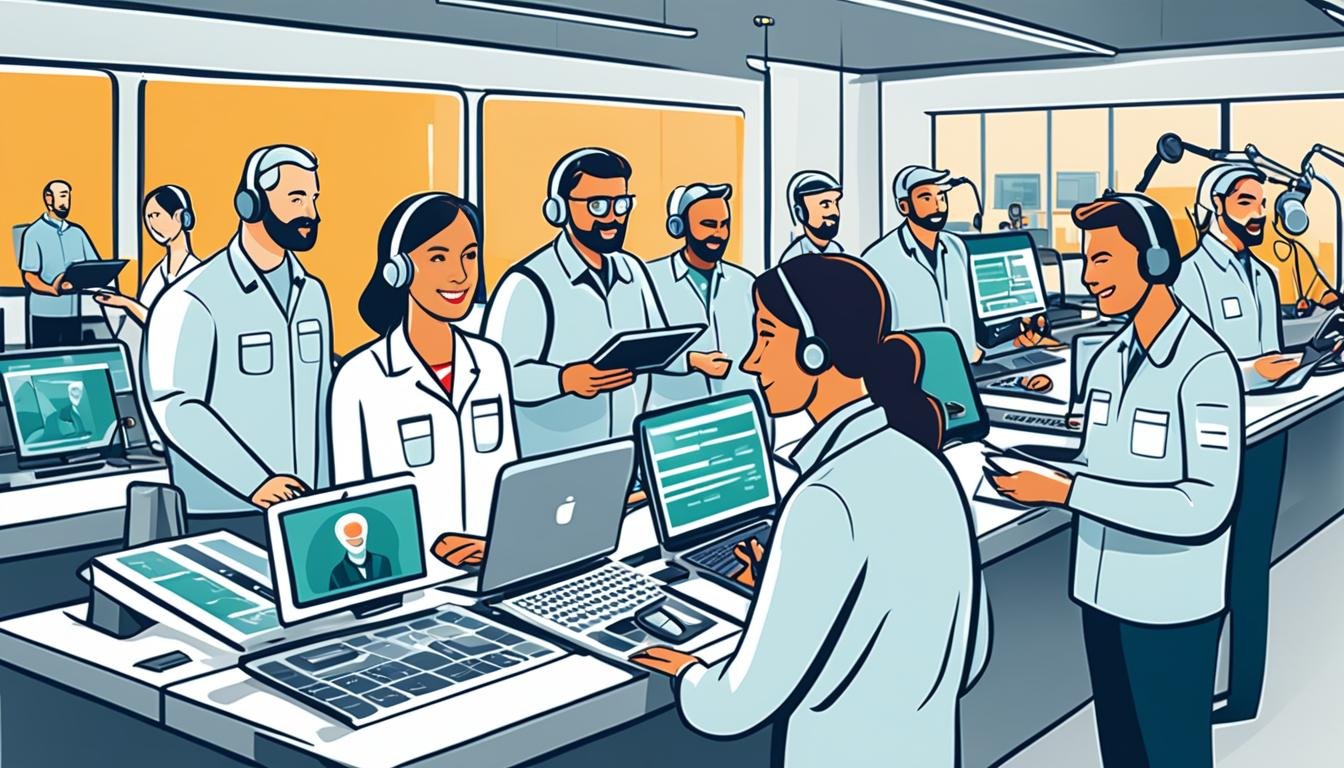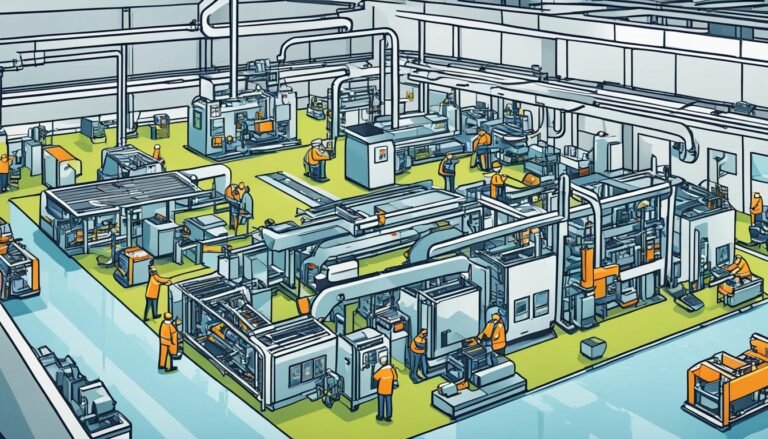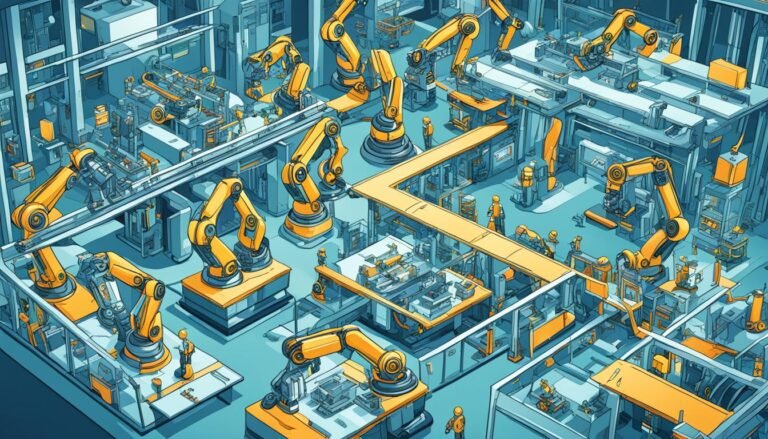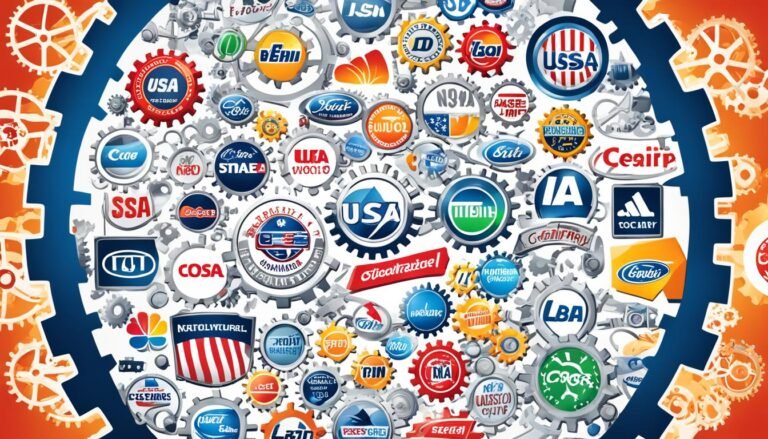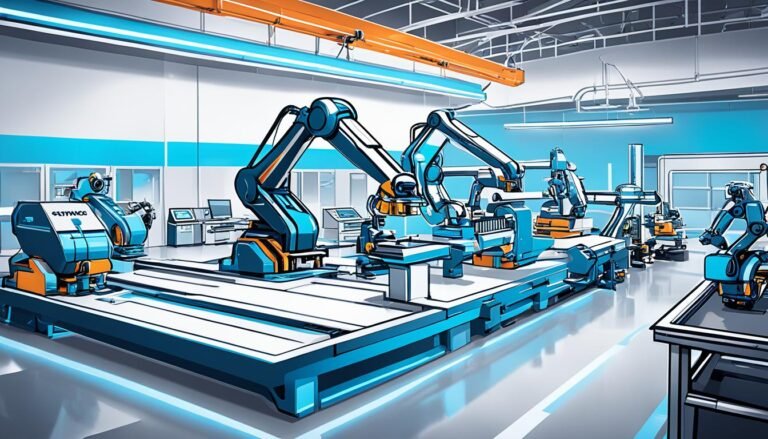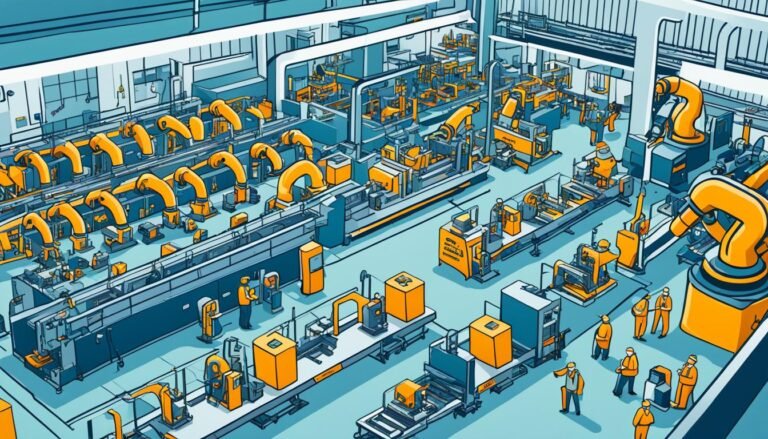Effective Communication in Manufacturing Settings
Did you know that 75% of manufacturing delays are due to communication problems between workers and bosses? This fact shows how crucial good communication is in manufacturing. The U.S. manufacturing sector makes up about 11% of the country’s total output and produced around $2.5 trillion in 2021.
Good communication is key to making operations run smoothly. It helps increase productivity, keeps employees on the same page, and encourages teamwork. But, in a field where making products is the main goal, talking often gets overlooked. This can cause big losses, as unhappy workers cost the U.S. economy between $483 billion to $605 billion a year.
But, there’s a lot of room for better communication. Most frontline workers believe new communication tools make them more productive. By using strong communication plans, manufacturers can work better, keep workplaces safe, and keep employees happy and on board.
Key Takeaways
- 75% of manufacturing delays are due to communication issues.
- The manufacturing sector accounts for about 11% of the U.S. total output.
- Disengaged manufacturing employees significantly impact lost productivity.
- 71% of frontline workers see improved productivity with updated communication tools.
- Effective communication can enhance operational efficiency, safety, and employee engagement.
Why Communication is Crucial in Manufacturing
Effective communication is key to a successful manufacturing process. It ensures that processes run smoothly, keeps employees engaged, and helps cross-functional teams work together well.
Impact on Productivity
Good communication is vital for team coordination in manufacturing. It helps spot and fix problems quickly. This means less downtime and more work gets done, making things more productive.
Influence on Workplace Safety
Safety is a top priority in manufacturing. Good communication helps share safety rules, train workers, and warn about risks. This keeps the workplace safe and lowers the chance of accidents.
Employee Engagement and Retention
When workers feel heard and informed, they’re more engaged. This leads to happier, more motivated employees. Sadly, only 25% of non-desk workers in manufacturing feel engaged. But, good communication can change this, making workers feel part of a team and leading to better job satisfaction.
Digital tools like Beekeeper are changing how we communicate in manufacturing. They offer features like instant messaging, safety alerts, and group chats. These tools aim to boost productivity, safety, and engagement like never before.
| Aspect | Impact of Effective Communication |
|---|---|
| Process Optimization | Enhances defect resolution and productivity |
| Workplace Safety | Reduces risks and disseminates safety protocols efficiently |
| Employee Engagement and Retention | Boosts job satisfaction, motivation, and retention rates |
Common Communication Challenges in Manufacturing Settings
Manufacturing settings face many communication challenges that slow down the flow of important information. These hurdles affect efficiency, how engaged employees are, and overall productivity.
Information Overload
The amount of data from manufacturing processes can be too much for employees. This makes it hard for them to focus on what’s really important. Without a clear plan for sharing information, about 60% of companies struggle with this.
Disconnected Communication Methods
When communication is not connected, messages get lost or hard to find. This is a big problem for deskless workers, who make up 80% of the global workforce. Also, 82% of manufacturing CEOs say it’s tough to talk to employees on the floor. This leads to less efficient operations and less workplace collaboration.
Language Barriers
Manufacturing jobs often require workers who speak different languages. Without ways to communicate in these languages, there can be misunderstandings. Using digital tools that translate can help make sure everyone understands each other, no matter what language they speak.
| Challenge | Impact | Possible Solutions |
|---|---|---|
| Information Overload | Hampered prioritization and processing | Streamline information flow, employ consistent internal communication strategies |
| Disconnected Communication Methods | Inconsistent and inaccessible messages | Utilize unified communication platforms, enhance CEO-employee interaction |
| Language Barriers | Misunderstandings and misinterpretations | Implement multilingual digital communication tools |
Strategies for Improving Communication
To overcome communication barriers in manufacturing, we need strategic steps. Using effective communication strategies helps with smoother operations, safer workplaces, and better quality control.
Using Digital Communication Tools
In today’s fast-changing manufacturing world, using digital tools is key. Tools like email, messaging apps, and ERP/MRP systems improve communication and sharing information. They make Operational Efficiency better by giving everyone, including deskless workers, real-time data.
Interestingly, 71% of frontline workers say modern communication tools make them more productive.
Regular Feedback Mechanisms
Regular feedback is a great way to improve continuously in manufacturing. Feedback should happen often, as 43% of engaged employees get feedback weekly. This helps solve problems fast and keeps everyone on the same page with company goals.
Consistent feedback also makes Communication Strategies better, leading to fewer accidents and happier employees.
Training and Development Programs
Investing in strong training and development programs is key. Programs like “training buddies” help new hires fit in faster, improving teamwork. Training on safety and new tech should be clear and include extra materials for learning.
A well-trained team improves Quality Control and boosts morale. Companies that focus on ongoing development see more retention and engagement.
Benefits of Effective Communication in Manufacturing
In manufacturing, clear communication is key. It helps in many ways, from making things run smoothly to keeping workers happy. Good communication means better quality, more efficiency, and happier employees.
Operational Efficiency
Good communication helps make things run fast and right. In manufacturing, where time is money, clear messages avoid mistakes and delays. This leads to more work getting done and less time wasted.
Tools that make talking easy are important. They help keep production moving and follow Lean Manufacturing ideas.
Enhanced Quality Control
When workers know what to do quickly, they make better products. Good communication keeps everyone following the rules and making quality products. This means fewer mistakes and happier customers.
Communication is key to a strong quality control culture. It helps make sure customers are happy and products are top-notch.
Boosted Employee Morale
When workers feel they’re heard, they’re happier. Clear communication makes them more satisfied with their jobs. Happy workers stay with the company longer, saving money on hiring and training.
Open communication also helps workers get along better. It leads to fewer conflicts and a positive workplace. This makes for a dedicated and successful team.
Source Links
- Effective Communication in Manufacturing (The 6 Key Steps)
- 12 Easy Ways to Improve Manufacturing Communications – Beekeeper
- Effective Communication for Manufacturing Companies | MANTEC
- The Crucial Role of Communication in the Manufacturing Industry
- A Reliable Solution To Boost Communication In Manufacturing Companies
- What Does Manufacturing Workplace Communication Have To Do With Organisational Success?
- Internal Comms for Manufacturing – The Ultimate Guide
- Internal Communications in Manufacturing: The Ultimate Guide
- How to Communicate Effectively in a Manufacturing Company? – MRPeasy
- 7 Steps to Effective Communication with Factory Workers
- The Importance of Good Communication on the Factory Floor – Azumuta
- Effective Communication in the Workplace
- Top 8 Benefits of Effective Communication in the Workplace

